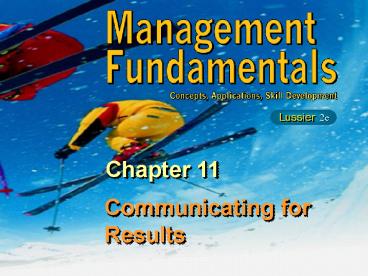Communicating for Results - PowerPoint PPT Presentation
1 / 29
Title:
Communicating for Results
Description:
Communication Channels. The three primary channels are oral, nonverbal, and written. ... nonverbal communication. Make sure your nonverbal communication ... – PowerPoint PPT presentation
Number of Views:394
Avg rating:3.0/5.0
Title: Communicating for Results
1
Communicating for Results
Chapter 11
2
Learning Outcomes
3
Learning Outcomes (contd)
4
Communication General facts
- 75 of working day spent on communicating
- 75 loss through imprecision, inaccuracy, etc.
- It is the process of transmitting information and
meaning - Organisational along units/departments in
organisation - Interpersonal among people
5
Organisational Communication
- Important skill for managers
- Lee Iacocca The most important thing I learned
in (business) school was how to communicate - Types of organisational communications
- Vertical
- Down
- Up
- Facilitating upward communication
- Horizontal/lateral
- Grapevine
6
Organisational Communication
- Vertical Communication
- The flow of information both downward and upward
through the organisational chain of command. - Horizontal Communication
- The flow of information between colleagues and
peers. - Grapevine
- The flow of information in any direction
throughout the organisation.
7
Organisational CommunicationFormal Communication
8
Organisational CommunicationInformal
Communication
9
What is communicated to you I this picture?
10
The Communication Process
Exhibit 112
11
The Communication Process
- Encoding
- The senders process of putting the message into
a form that the receiver will understand. - Communication Channels
- The three primary channels are oral, nonverbal,
and written. - Decoding
- The receivers process of translating the message
into a meaningful form.
12
Major Communication Barriers
13
Message Transmission Channels
14
Oral Communications
- Advantages
- Easier
- Faster
- Encourages feedback
- Disadvantages
- Less accurate
- Leaves no permanent record
15
Nonverbal Communications
- Nonverbal Communication
- Includes messages sent without words.
- Setting (physical surroundings)
- Body language
- Facial expressions
- Vocal quality (how said, not what said)
- Gestures
- Posture
- Disadvantage
- Can be misinterpreted by receiver.
16
Written Communications
- Advantages
- More accurate
- Provides a permanent record
- Disadvantages
- Takes longer
- Hinders feedback
17
Selecting the Message Transmission Channel
- Media Richness
- The amount of information and meaning conveyed
through a channel. - Oral channels (e.g., face-to-face) are the
richest channels, useful for sending difficult
and unusual messages. - Written channels are less rich, useful for simple
and routine messages. - Combined channels are best used for important
messages that must be attended to.
18
Sending Messages
- Planning the Message
- What is the goal of the message?
- Who should receive the message?
- How should the message be sent?
- When should the message be sent?
- Where should the message be sent?
19
The Face-to-Face Message-Sending Process
1. Develop rapport.
2. State your communication objective.
3. Transmit your message.
4. Check receivers understanding.
5. Get a commitment and follow up.
20
Checking Understanding Feedback
- Feedback
- The process of verifying messages.
- Paraphrasing
- The process of having the receiver restate the
message in his or her own words. - Feedback Problems
- Receivers feel ignorant.
- Receivers are ignorant.
- Receivers are reluctant to point out senders
ignorance.
21
Checking Understanding Feedback
- How to Get Feedback
- Be open to feedback
- There are no dumb questions.
- Be aware of nonverbal communication
- Make sure your nonverbal communication encourages
feedback. - Ask questions
- Dont take action before checking on message.
- Use paraphrasing
- Check the receivers interpretation of your
message.
22
The Message-Receiving Process
23
Response Styles
24
Response Styles
- Advising
- Providing evaluation, personal opinion,
direction, or instructions. - Diverting
- Switching the focus of the communication.
- Probing
- Asking the sender for more information.
- Reassuring
- Responding to reduce the intensity of emotions.
- Reflecting
- Paraphrasing the message to indicate acceptance
and understanding.
25
Calming an Emotional Person
- Empathic Listening
- The ability to understand and relate to anothers
situation and feelings. - Dealing with Emotional People
- Dont make statements putting the person down.
- Do make reflective empathic responses.
- Paraphrase feelings.
26
(No Transcript)
27
(No Transcript)
28
(No Transcript)
29
(No Transcript)































